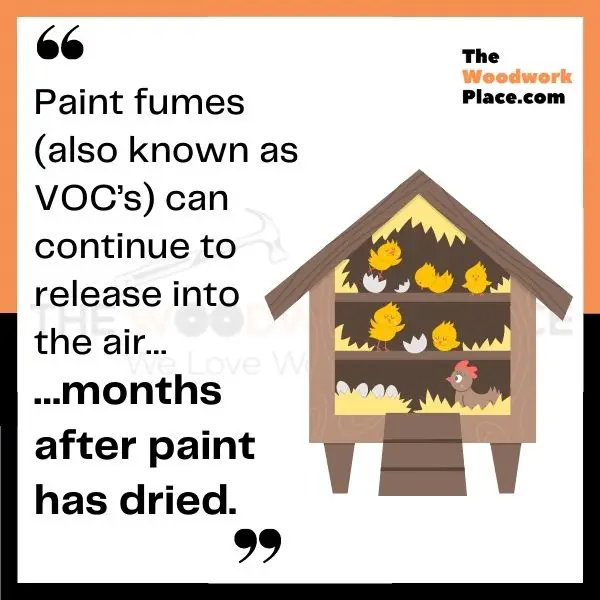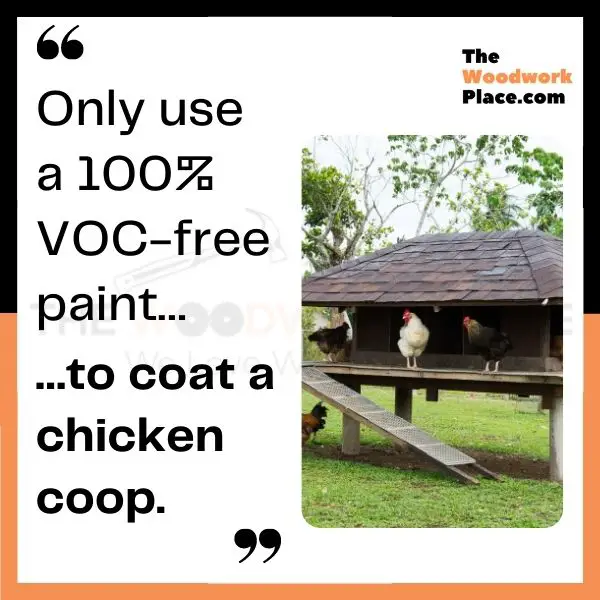What came first, the chicken or the egg? It was the chicken coop of course!
And a home made chicken coop is the perfect woodworking project for anyone who likes having a steady supply of freshly laid free-range eggs.
Now, we all know that healthy chickens thrive in safe hen houses. But, will painting a hen house turn it into a hazardous habitat?
Well, in this post, you will learn why you need to be very wary of paint fumes. You will also learn why paint fumes can still prove harmful to chickens (even long after paint dries).
And we reveal which fume-free paint is safe enough to give your chicken coop a pop of color.

This post may contain affiliate links to products that we receive a commission for (at no additional cost to you). Learn more here.
Can You Safely Paint A Chicken Coop?
If you want to keep your chickens happy and healthy, you need to do everything you can to keep them away from toxic paint fumes.
Related Post: Can You Paint Green Wood? (Solved!)
When chemical solvents in paint evaporate, those fumes (also known as Volatile Organic Compounds or VOC’s) can be absolutely lethal to poultry.
Are Paint Fumes Really That Dangerous For Chickens?
Yes, wet paint fumes will harm chickens, but its worse than that…
While paint dries, you can clearly smell those VOC’s. However, what you may not know is that even after paint dries, VOC’s can continue to release into the air for up to 6 months!
In other words, even dry paint could pose a risk to your chickens delicate lungs.
What Are Volatile Organic Compounds? Often referred to as VOC’s, Volatile Organic Compounds are the gases that get released while paint dries.
What Kind Of Paint Is Safe For A Chicken Coop?
You should only use 100% VOC-free paint to coat a chicken coop. VOC-free paints are odorless and have no dangerous chemical solvents in them.
Sometimes they are made from all natural ingredients. And other times they’re made from solvent-free synthetic ingredients.
Using this special type of paint means that you needn’t worry about paint fumes poisoning the air around your poultry.

Does That Mean Spray Paint Is Toxic To Chickens?
Spray paint is filled to the brim with zinc, lead, and a plethora of VOC releasing chemicals. It would be dangerous for your chickens, if you were to use spray paint on a chicken coop.
What’s more, spray paint is an aerosol paint. Which means that it’s VOC content is even greater than that of other types of paint, (such as acrylic paint).
Can You Use Acrylic or Oil Paint In A Chicken Coop?
If the safety of your birds is of the utmost importance, then avoid using acrylic or oil paint to coat a chicken coop.
Water-based acrylic paints will emit less VOC’s than solvent-based oil paint. Yet both types are equally guilty of releasing harmful fumes – even long after they’ve dried.
Related Post: Is Teak Oil Safe For Birds? (How To Safely Finish A Bird House)
So, What Is The Best Non-Toxic Paint For A Chicken Coop?
First off, VOC-free paints generally come in two broad categories; natural and synthetic.
Both VOC-free paint types are safe to use on a chicken coop. However, natural VOC-free paints are made from all natural ingredients (like essential oils and plant resins).
These natural ingredients can foster the growth of mold and mildew. Particularly if you where to use these natural paints on outdoor structures.
Which is why, ideally, you should use a VOC-free paint made from synthetic ingredients. These paints won’t release harmful fumes, and they won’t encourage mold growth on days when humidity is high either.
And, one of the best fume-free synthetic paints on the market is Little Knights 100% VOC-free paint. This high quality product is odorless, allergen-free, and doesn’t have any carcinogenic ingredients added to it.
You can find out more about Little Knights VOC-free paint over on their official website right here.

And Is It Safe To Paint The Inside Of A Chicken Coop?
It can be tempting to want to paint the inside of a chicken coop. Especially when a light coat of paint will make it easier to check and clean the interior of a hen house.
And, unlike other birds, chickens don’t tend to chew wood. Which means that they are unlikely to ingest any paint covered lumber.
So, once that VOC free paint has dried and cured, it won’t pose a risk to the health and safety of chickens if you used it to paint the inside of that coop.
What Is The Difference Between Dry And Cured Paint?
When a water-based paint is dry, it has completed an evaporation process. The water in it has evaporated, leaving behind a solid (but still soft) film of paint.
However, when paint has cured, it has gone through a chemical process. And this chemical process turns that residual solid film into a firm durable coat.
So, Just To Double Check, Should A Chicken Coop Be Painted On The Inside?
It’s more of a personal choice really.
If you want to err on the side of caution, then you’re better off leaving the interior of the coop free of any kind of finish or paint.
This isn’t the best thing for the longevity of that coop lumber. Yet it’s by far the safest choice for your chickens.
Related Post: Is There A Safe Non-Toxic Wood Sealer For Chicken Coops?
To Sum Up, Here Are The 3 Main Takeaways…
- 1). The fumes released from fresh paint can be very harmful to chickens.
- 2). These fumes (also known as VOC’s) can continue to release into the air for months after paint has dried.
- 3). So, only use a 100% VOC-free paint to coat a chicken coop.

